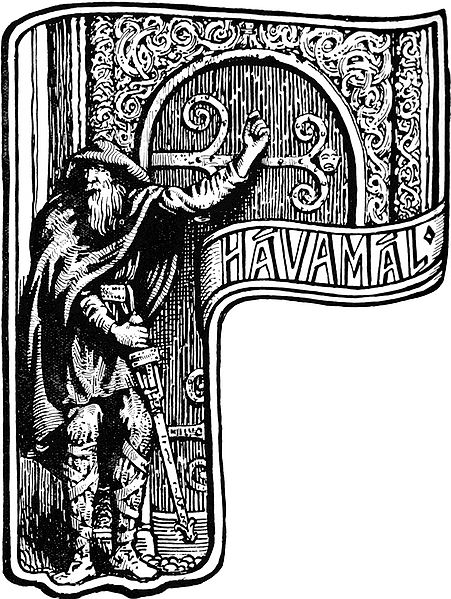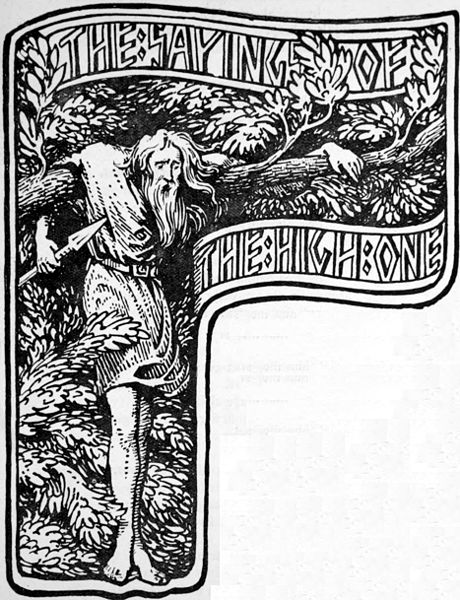Hávamál is the second part of the Older Edda (OE) or Poetic Edda.
Illustration to the Older Edda by W.G.Collingwood, 1854-1932. See verse 1.
INTRODUCTORY NOTE by Henry Adams Bellows
This poem follows the Voluspo in the Codex Regius, but is preserved in no other manuscript. The first stanza is quoted by Snorri, and two lines of stanza 84 appear in one of the sagas.
In its present shape it involves the critic of the text in more puzzles than any other of the Eddic poems. Without going in detail into the various theories, what happened seems to have been somewhat as follows. There existed from very early times a collection of proverbs and wise counsels, which were attributed to Othin just as the Biblical proverbs were to Solomon. This collection, which presumably was always elastic in extent, was known as "The High One's Words," and forms the basis of the present poem. To it, however, were added other poems and fragments dealing with wisdom which seemed by their nature to imply that the speaker was Othin. Thus a catalogue of runes, or charms, was tacked on, and also a set of proverbs, differing essentially in form from those comprising the main collection. Here and there bits of verse more nearly narrative crept in; and of course the loose structure of the poem made it easy for any reciter to insert new stanzas almost at will. This curious miscellany is what we now have as the Hovamol.
Five separate elements are pretty clearly recognizable: (1) the Hovamol proper (stanzas 1-80), a collection of proverbs and counsels for the conduct of life; (2) the Loddfafnismol (stanzas 111-138), a collection somewhat similar to the first, but specifically addressed to a certain Loddfafnir; (3) the Ljothatal (stanzas 147-165), a collection of charms; (4) the love-story of Othin and Billing's daughter (stanzas 96-102), with an introductory dissertation on the faithlessness of women in general (stanzas 81-95), which probably crept into the poem first, and then pulled the story, as an apt illustration, after it; (5) the story of how Othin got the mead of poetry--the draught which gave him the gift of tongues--from the maiden Gunnloth (stanzas 103-110). There is also a brief passage (stanzas 139 146) telling how Othin won the runes, this passage being a natural introduction to the Ljothatal, and doubtless brought into the poem for that reason.
It is idle to discuss the authorship or date of such a series of accretions as this. Parts of it are doubtless among the oldest relics of ancient Germanic poetry; parts of it may have originated at a relatively late period. Probably, however, most of its component elements go pretty far back, although we have no way of telling how or when they first became associated.
It seems all but meaningless to talk about "interpolations" in a poem which has developed almost solely through the process of piecing together originally unrelated odds and ends. The notes, therefore, make only such suggestions as are needed to keep the main divisions of the poem distinct.
Few gnomic collections in the world's literary history present sounder wisdom more tersely expressed than the Hovamol. Like the Book of Proverbs it occasionally rises to lofty heights of poetry. If it presents the worldly wisdom of a violent race, it also shows noble ideals of loyalty, truth, and unfaltering courage.
Billing’s girl watching Odin approaching, dog in between, Lorenz Frølich, 1820-1908, Copenhagen. See verses 96-102.
for the whole library.
Eddukvæði I, Goðakvæði, Jónas Kristjánsson og Vésteinn Ólason gáfu út, p. 322-355, Íslenzk fornrit, Reykjavík 2014.
Den Høie's ord (Hǫ́vamǫ́l), tr. G.A Gjessing, Kristiania 1899.
VOLUSPO, The Wise-Woman's Prophecy, tr. Henry Adams Bellows, in the Poetic Edda, the American-Scandinavian Foundation, 1936.
http://www2.hf.uio.no/common/apps/permlink/permlink.php?app=polyglotta&context=volume&uid=7477a741-06fc-11e6-98cc-0050569f23b2

 Verse 1-10
Verse 1-10
 Verse 11-20
Verse 11-20
 Verse 21-30
Verse 21-30
 Verse 31-40
Verse 31-40
 Verse 41-50
Verse 41-50
 Verse 51-60
Verse 51-60
 Verse 61-70
Verse 61-70
 Verse 71-80
Verse 71-80
 Verse 81-90
Verse 81-90
 Verse 91-100
Verse 91-100
 Verse 101-110
Verse 101-110
 Verse 111-120
Verse 111-120
 Verse 121-130
Verse 121-130
 Verse 131-140
Verse 131-140
 Verse 141-150
Verse 141-150
 Verse 151-160
Verse 151-160
 Verse 161-164
Verse 161-164


